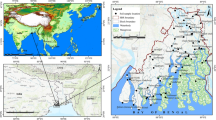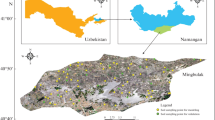Abstract
Rising soil salinity has been a major problem in the soils of Egypt in recent decades. High water tables are also a common problem in intensively irrigated areas and can lead to the development of salinity problems. Results show a high correlation between ETM+ band 3 and salt efflorescence. The ground values have a good correlation (r 2 > 0.65) with estimated values. Results also show a positive correlation (r 2 = 0.84) between the concentration of salt on the surface and water table levels of 70 cm or less. In the area under study, salt accumulation, ground water and inadequate drainage conditions are the major causes of salinization.
Similar content being viewed by others
References
Afify, H.F., Studies on Water Resources and Pollution in Some Areas of the Suez Canal Province, Univ. of Cairo, 2000.
Csillag, F. and Biel, L.L., Spectral Band Selection for the Characterization of Salinity Status of Soil, Remote Sensing Environ., 1993, vol. 43, pp. 231–242.
de Dapper, M. and Goossens R., Modeling and Monitoring of Soil Salinity and Water Logging Hazards in the Desert-Delta Fringes of Egypt Based on Geomorphology, Remote Sensing and GIS, Proc. 16th Earsel Symp., Malta, May 20–23, 1996.
Dwivedi, R.S., Monitoring and the Study of the Effect of Image Scale on Delineation of Salt Affected Soils in the Indo-Gangentic Plains, Int. J. Remote Sensing, 1992, vol. 13, pp. 1527–1536.
Eger, H., Fleischhauer, E., Hebel, A., and Sombroek, W., Taking Action for Sustainable Land Use, Proc. 9th ISCO Conf., Bonn, 1996, pp. 480–483.
FAO. The Land Resource Base. Room: FAO (ARC/86/3), Roma, 1986.
Hillel, D., Salinity Management for Sustainable Irrigation: Integrating Science, Environment and Economics, Washington, 2000.
Kalkhan, M.A., Stohlgren, T.J., Chong, G.W., et al., A Predictive Spatial Model of Plant Diversity: Integration of Remotely Sensed Data, GIS and Spatial Statistics, Proc. 8th Biennial Remote Sensing Application (Conf. RS, 2000), Albuquerque, 2000, pp. 1–8.
Northrop, L.J., Landsat Detection of Irrigation Area Salinity, Occasional Paper Ser., 1982, no. 4.
Zinck, J.A., Remote Sensing of Soil Salinization Impact on Land Management, New York, 2009.
Author information
Authors and Affiliations
Additional information
Original Russian Text © E.S. Mohamed, E.G. Morgun, S.M. Goma Bothina, 2011, published in Vestnik Moskovskogo Universiteta. Pochvovedenie, 2011, No. 1, pp. 13–16.
About this article
Cite this article
Mohamed, E.S., Morgun, E.G. & Goma Bothina, S.M. Assessment of soil salinity in the Eastern Nile Delta (Egypt) using geoinformation techniques. Moscow Univ. Soil Sci. Bull. 66, 11–14 (2011). https://doi.org/10.3103/S0147687411010030
Received:
Published:
Issue Date:
DOI: https://doi.org/10.3103/S0147687411010030




